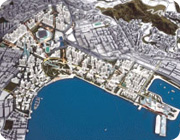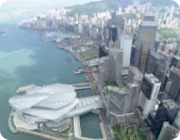BUILDING
DCS in Hong Kong, China
Air conditioning accounts for 30% of Hong Kong, China's electricity consumption on average. To improve the environment and conserve energy in Hong Kong, China, one of the major Government's initiatives is to reduce energy consumption on air-conditioning in buildings.
The Government of the Hong Kong Special Administrative Region of the People's Republic of China (the "Government") has completed two implementation studies of DCS in South East Kowloon Development (SEKD) and Wanchai and Causeway Bay (WCCB) districts. These two studies represent two scenarios of the newly developed district and existing developed district.


Currently, to further promote energy efficiency and conservation, the Government plans to implement a district cooling system at the Kai Tak Development (KTD) to supply chilled water to buildings in the new development area for centralised air-conditioning. KTD, with a planned total of about 1.7 million square metres (m2) in public and private non-domestic air conditioned floor areas requiring about 284 megawatt (MW) cooling capacity, presents a unique opportunity for implementation of a DCS in Hong Kong, China.
The project is to construct a large scale centralized air-conditioning system which produces chilled water at its central chiller plants and distributes the chilled water to user buildings in KTD through an underground water piping network. The implementation of this project can bring about significant environmental benefits. The maximum annual saving in electricity consumption will be up to 85 million kilowatt-hour, equivalent to a reduction of 59 500 tonnes of carbon dioxide emission per annum for the planned total public and private non-domestic air-conditioned floor area of about 1.7 million m2.
The estimated cost about $4,900 million is required to build this district cooling system. The project will be developed and commissioned for operation in phases. The construction of Phase I and Phase II commenced in 2011 and were completed in 2013 and 2014 respectively. Construction of Phase III commenced in 2013 and is expected to be completed in 2025.